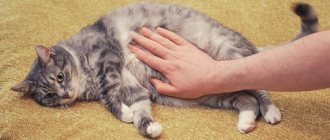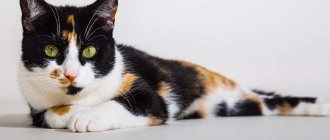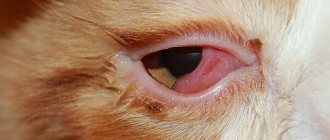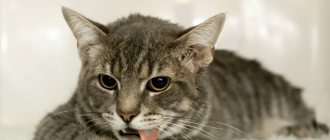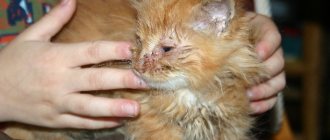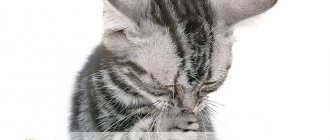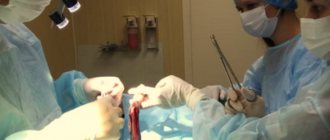A cat's lip ulcer may be caused by Jacobs disease. The disease is similar to herpes rashes on the human lip. More often, the disease affects cats that have reduced immunity.
Pedigree cats, especially the British breed, are also more often susceptible to the disease. Jacobs disease is manifested by defects in the skin, most often an ulcer on the upper or lower lip, but with extensive damage, defects in the integrity of the mucous membrane of the cheeks and abdominal skin are possible.
Jacobs ulcer
This defect most often affects the upper lips of the purr, although in rare cases such a sore can form on the lower lip or directly in the mouth. Jacobs' ulcer in cats is a disease of predominantly purebred individuals, who have weaker immunity and genotype in comparison with their domestic relatives. Some sources also call the above disease eosinophilic ulcer or eosinophilic granuloma. Jacobs ulcer is considered a precancerous condition of the skin. Without timely and proper treatment, the above ailment often develops into fibroma or sarcoma.
Causes
To date, scientists have not come to a final decision as to what exactly - allergies, parasites, viruses or genetic predisposition - causes Jacobs ulcer.
However, there are six factors that influence the acceleration of the development of this disease.
- Poor nutrition.
- Feeding poor quality food.
- Recent bacterial or viral illnesses.
- Exhaustion of the cat's body.
- Cachexia.
- The cat's predisposition to allergic reactions.
Symptoms
A small reddish spot appears on your furry pet’s lip, most often on the upper lip, which over time can turn into a huge stinking eczema. In this case, the cat will not feel pain or even basic itching. If you start treatment, then in the future you can observe ulceration of the foul-smelling spot, as well as its deepening. The cat will begin to suffer from pain, the animal will lose its appetite and become lethargic. This stage of the disease has dubious prospects for healing.
Treatment of Jacobs ulcer
If a veterinarian accurately diagnoses this type of ulcer, pets are treated for approximately three weeks with corticosteroids - Sulfetrim, Prednisolone or Depo-Medrol. True, the above remedies will be very effective only in the early stages of Jacobs ulcer. “Patching” holes in the cheeks will have to be done exclusively by surgical methods.
Probiotics
To normalize the intestinal microflora, including after taking medications, lactobacilli are recommended for cats. Taking the lyophilized form for humans (Lactobacterin) gives unsatisfactory results.
For cats with Jacobs ulcer, other skin infectious and inflammatory diseases, intoxication, allergies, disorders of the digestive system, liver, and kidneys, veterinarians prescribe Lactis Zoo. The drug contains 16 types of fermented lactobacilli.
Pharmacological properties of Lactis Zoo:
- activates the immune system by restoring intestinal function;
- relieves signs of intoxication;
- reduces allergenicity;
- improves the condition of the skin and coat.
The dosage regimen is determined by the veterinarian based on the condition of the animal and its weight.
Corneal ulcer
A corneal ulcer in a cat is always a consequence of trauma or other damage to the eyes, as well as the development of certain infections.
Healthy eye after corneal ulcer
Types of corneal ulcers in cats and their signs
There are purulent and perforated corneal ulcers.
Symptoms of a purulent ulcer
- Photophobia.
- Severe pain.
- Corneal defects of various shapes and sizes.
- Discharge of mucopurulent fluid from the eye.
- Blepharospasm.
- Vascularization.
- Clouding of the edges of ulcers.
- Swelling at the edges of ulcers.
Symptoms of a perforated ulcer
- Part of the cornea has a gray-blue tone.
- The iris most often falls out in the center.
- Mixed vascularization is observed.
Corneal ulcers are fraught not only with scars, but also with macula, leukoma or nubecula.
Treatment of corneal ulcers
All cats with rapidly progressing corneal ulcers must be hospitalized. Aibolit puts a special collar on the purr so that the animal cannot damage its eyes.
Antibiotics in the form of ointments are lubricated into the conjunctival sac 2-4 times a day. Solutions are instilled every 3-6 hours. Tobramycin, Gentamicin, Chloramphenicol and Terramycin may be prescribed.
The drug Acetylcysteine, which is instilled into the cat's sore eye on average every 3 hours, has good anti-collagenolytic characteristics.
Aspirin is an excellent pain reliever and relieves inflammation. Cats are given it after 48 hours at 10 mg/kg.
To protect the cornea from irrigation, reduce pain, and prevent leakage of medications, contact lenses may be prescribed to a sick cat.
Each type of treatment for a corneal ulcer should be prescribed exclusively by a qualified veterinarian, since the use of most medications has some contraindications.
Superficial ulcers are predominantly treated with conservative methods.
Surgeries are inevitable for descemetocele, as well as ulcers whose size exceeds 50% of the thickness of the cornea. All operations are fraught with possible serious complications, including complete blindness, therefore caring cat owners are strictly contraindicated to delay contacting veterinary clinics when the first pathological symptoms are detected.
Steroid medications
Glucocorticosteroids (GCS) are prescribed to relieve inflammation, reduce allergic manifestations, and relieve swelling. Depending on the condition of the animal, the veterinarian selects the drug and method of application.
For severe acute forms of inflammation, corticosteroids by injection are recommended: prednisolone, dexamethasone.
These drugs have the following therapeutic effects:
- suppress the functions of leukocytes and tissue macrophages;
- reduce capillary permeability due to the release of histamine;
- increase blood glucose levels, stimulating insulin production;
- relieve inflammation;
- reduce swelling.
Due to the strong immunosuppressive effect and the risk of peptic ulcers of the digestive system, the drugs are prescribed under the supervision of a doctor, strictly following the dosage, observing the duration of the course.
In order to relieve itching and restore the skin, a combined oral preparation, Stop-Itch, is prescribed, which is less toxic and safer than its analogues. The active ingredient is the steroid triamcinolone, and the auxiliary ingredients are pyridoxine, riboxin, succinic acid, and methionine. The drug prevents the production of inflammatory mediators, stabilizes the permeability of cell membranes, and improves the functional condition of the skin.
Stomach ulcers
There are two types of stomach ulcers.
- Simple gastric ulcers in cats with an irregular shape and relatively good healing
- Peptic ulcers with a round shape and thick edges.
Causes
This disease occurs quite often in cats, since there are many reasons for its occurrence.
- Various wounds, injuries and other damage to the gastric mucosa, for example, a purr may accidentally swallow a small bone or nail.
- Stress.
- Poisoning.
- Long-term feeding with cheap dry food, such as Whiskas.
- Chronic pancreatitis.
Symptoms
It is difficult not to recognize a stomach ulcer, since any cat owner will see its signs.
- Weight loss.
- Loss of appetite.
- Vomit.
- Depressed state of the animal.
Treatment methods for stomach ulcers in cats
Having diagnosed a stomach ulcer in your furry pet, the veterinarian will prescribe sedatives, painkillers and antispasmodics, as well as drugs that protect the walls of the stomach and help speed up scarring.
But treatment of this disease cannot guarantee any effect without the use of diet therapy. A recovering purr should be fed lukewarm and semi-liquid food - purees, soups and soufflés, 3-5 times a day. The veterinarian will most likely recommend one of the ready-made diets - Royal Canin, Ekanuba or Hills.
Injuries
Cats are very curious: even a pet that has no chance of getting outside can find adventure in its face while exploring the apartment. A small wound (for example, when trying to bite a cactus - this happens!) will most likely heal quickly. However, for some time a small sore or ulcer will be noticeable in its place.
An animal may become interested in the stove or heater that has just been turned off, and get burned: the burn also leaves a mark in the form of a sore.
We recommend the article: Why does a cat constantly stick out its tongue?
Indolent ulcer
Indolent, otherwise called eosinophilic, ulcers in cats are localized in most cases above the upper lip.
The early stages are manifested by small ulcers with a concave surface. As the above disease progresses, the size of the lesions increases and acquires a reddish-brown tint. In the future, such ulcers will be characterized by slightly raised edges, as well as ulcerated masses.
How to properly treat an indolent ulcer? Aibolit prescribes a course of glucocosteroids for the cat (this can be cyclosporine, prednisolone or similar drugs), as well as antibiotics (amoxicillin and clavulanic acid are most often prescribed).
Prevention of the formation of purulent abscesses
- Excluding contact with stray cats and dogs.
- Castration of males.
- Eliminate bones from your cat's diet.
- Complete and balanced feeding.
- Regular preventive veterinary examinations of the animal with assessment of the condition of the teeth and gums, especially in old animals.
- Maintaining the hygiene of the cat’s habitat: regularly changing the tray, washing the bowl, cleaning the room.
- To support the animal’s immunity, use vitamin and mineral supplements from Beafar and AgroVetZashchita.
Quantity
Ulcers on the tongue
An ulcer on the tongue in cats is one of the manifestations of calcivirosis. Calcivirosis is a feline viral disease that affects the respiratory system. The causative agent of this disease almost does not react to most disinfectants.
To prevent your cat from getting calcivirus, ventilate the room better and more often, vaccinate your furry pet against this disease in a timely manner, and also do not keep a large enough number of felines in the house.
Calcivirus is transmitted through direct contact by sneezing.
When cells affected by calcivirosis are destroyed, erosions and ulcers often form in the oral cavity and on the mucous membranes of the respiratory tract.
The cat, at the same time, refuses food, its body temperature can rise to 40C. The tongue, hard palate, lips and even the tip of the nose can be affected by ulcers.
Medicine does not have specific drugs against this bacterial infection. However, calcivirosis can be treated quite effectively in several ways.
- To prevent the development of a viral infection on a weakened cat’s body, antibiotics are prescribed.
- The antiviral immune response is stimulated using feline immunostimulants.
- Prevention of dehydration.
- Antipyretic drugs.
- Prescription of adaptogens and vitamins.
- Sanitation of the cat's oral cavity with Dentavidin, Miramistin, chamomile decoction or a weak solution of potassium permanganate.
Prevention of infectious rhinotracheitis
- Timely vaccination of kittens and adult cats (Multifel-3, Quadriket vaccines).
- Avoid contact with stray animals.
- Tray hygiene.
- Regular treatment against ectoparasites.
- Complete and balanced feeding.
- Elimination of stressful situations.
- Do not allow your cat to become hypothermic.
- Do not give the animal cold water.
Read the article “Comb for long-haired cats: Which one to buy?” – https://strazhchistoty.ru/cleanup/cleancats/rascheska-dlya-koshek.html

